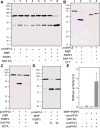Prophenoloxidase activation and antimicrobial peptide expression induced by the recombinant microbe binding protein of Manduca sexta
- PMID: 27989837
- PMCID: PMC5461653
- DOI: 10.1016/j.ibmb.2016.10.006
Prophenoloxidase activation and antimicrobial peptide expression induced by the recombinant microbe binding protein of Manduca sexta
Abstract
Manduca sexta microbe binding protein (MBP) is a member of the β-1,3-glucanase-related protein superfamily that includes Gram-negative bacteria-binding proteins (GNBPs), β-1,3-glucan recognition proteins (βGRPs), and β-1,3-glucanases. Our previous and current studies showed that the purified MBP from baculovirus-infected insect cells had stimulated prophenoloxidase (proPO) activation in the hemolymph of naïve and immune challenged larvae and that supplementation of the exogenous MBP and peptidoglycans (PGs) had caused synergistic increases in PO activity. To explore the underlying mechanism, we separated by SDS-PAGE naïve and induced larval plasma treated with buffer or MBP and detected on immunoblots changes in intensity and/or mobility of hemolymph (serine) proteases [HP14, HP21, HP6, HP8, proPO-activating proteases (PAPs) 1-3] and their homologs (SPH1, SPH2). In a nickel pull-down assay, we observed association of MBP with proHP14 (slightly), βGRP2, PG recognition protein-1 (PGRP1, indirectly), SPH1, SPH2, and proPO2. Further experiments indicated that diaminopimelic acid (DAP) or Lys PG, MBP, PGRP1, and proHP14 together trigger the proPO activation system in a Ca2+-dependent manner. Injection of the recombinant MBP into the 5th instar naïve larvae significantly induced the expression of several antimicrobial peptide genes, revealing a possible link between HP14 and immune signal transduction. Together, these results suggest that the recognition of Gram-negative or -positive bacteria via their PGs induces the melanization and Toll pathways in M. sexta.
Keywords: Hemolymph protease system; Insect immunity; Lys- or DAP-type peptidoglycan; Melanization; Pattern recognition; Toll pathway.
Copyright © 2016 Elsevier Ltd. All rights reserved.
Figures






Similar articles
-
A mechanistic analysis of bacterial recognition and serine protease cascade initiation in larval hemolymph of Manduca sexta.Insect Biochem Mol Biol. 2022 Sep;148:103818. doi: 10.1016/j.ibmb.2022.103818. Epub 2022 Aug 23. Insect Biochem Mol Biol. 2022. PMID: 36007679 Free PMC article.
-
Involvement of Manduca sexta peptidoglycan recognition protein-1 in the recognition of bacteria and activation of prophenoloxidase system.Insect Biochem Mol Biol. 2010 Jun;40(6):487-95. doi: 10.1016/j.ibmb.2010.04.008. Epub 2010 Apr 21. Insect Biochem Mol Biol. 2010. PMID: 20416376 Free PMC article.
-
Inhibition of immune pathway-initiating hemolymph protease-14 by Manduca sexta serpin-12, a conserved mechanism for the regulation of melanization and Toll activation in insects.Insect Biochem Mol Biol. 2020 Jan;116:103261. doi: 10.1016/j.ibmb.2019.103261. Epub 2019 Nov 4. Insect Biochem Mol Biol. 2020. PMID: 31698082 Free PMC article.
-
Innate immune responses of a lepidopteran insect, Manduca sexta.Immunol Rev. 2004 Apr;198:97-105. doi: 10.1111/j.0105-2896.2004.0121.x. Immunol Rev. 2004. PMID: 15199957 Review.
-
Pattern recognition proteins in Manduca sexta plasma.Insect Biochem Mol Biol. 2002 Oct;32(10):1287-93. doi: 10.1016/s0965-1748(02)00091-7. Insect Biochem Mol Biol. 2002. PMID: 12225919 Review.
Cited by
-
Serpin-9 and -13 regulate hemolymph proteases during immune responses of Manduca sexta.Insect Biochem Mol Biol. 2017 Nov;90:71-81. doi: 10.1016/j.ibmb.2017.09.015. Epub 2017 Oct 5. Insect Biochem Mol Biol. 2017. PMID: 28987647 Free PMC article.
-
A mechanistic analysis of bacterial recognition and serine protease cascade initiation in larval hemolymph of Manduca sexta.Insect Biochem Mol Biol. 2022 Sep;148:103818. doi: 10.1016/j.ibmb.2022.103818. Epub 2022 Aug 23. Insect Biochem Mol Biol. 2022. PMID: 36007679 Free PMC article.
-
Innate Immunity in Insects: The Lights and Shadows of Phenoloxidase System Activation.Int J Mol Sci. 2025 Feb 4;26(3):1320. doi: 10.3390/ijms26031320. Int J Mol Sci. 2025. PMID: 39941087 Free PMC article. Review.
-
Toll ligand Spätzle3 controls melanization in the stripe pattern formation in caterpillars.Proc Natl Acad Sci U S A. 2017 Aug 1;114(31):8336-8341. doi: 10.1073/pnas.1707896114. Epub 2017 Jul 17. Proc Natl Acad Sci U S A. 2017. PMID: 28716921 Free PMC article.
-
Pattern recognition, hemolymph protease-14 activation, and enhancement of lysozyme-mediated bacteria killing by soluble peptidoglycan recognition proteins in Manduca sexta.Insect Biochem Mol Biol. 2025 May;180:104297. doi: 10.1016/j.ibmb.2025.104297. Epub 2025 Mar 7. Insect Biochem Mol Biol. 2025. PMID: 40058531
References
-
- Dunn P, Drake D. Fate of bacteria injected into naïve and immunized larvae of the tobacco hornworm, Manduca sexta. J Invert Pathol. 1983;41:77–85.
-
- Gobert V, Gottar M, Matskevich AA, Rutschmann S, Royet J, Belvin M, Hoffmann JA, Ferrandon D. Dual activation of the Drosophila Toll pathway by two pattern recognition receptors. Science. 2003;302:2126–30. - PubMed
Publication types
MeSH terms
Substances
Grants and funding
LinkOut - more resources
Full Text Sources
Other Literature Sources
Molecular Biology Databases
Research Materials
Miscellaneous

